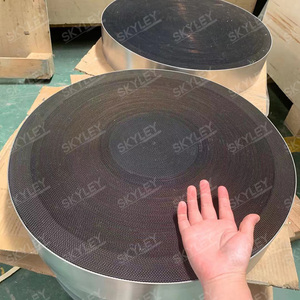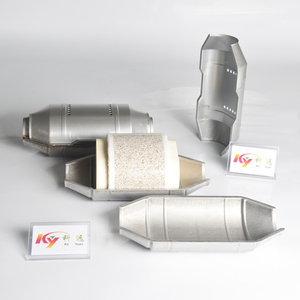
All categories
Featured selections
Trade Assurance
Buyer Central
Help Center
Get the app
Become a supplier

(1091 products available)




















































A catalytic converter for diesel generator reduces harmful emissions before they exit the diesel generator's exhaust system. The converter uses chemical reactions to transform nitrogen oxides (NOx), hydrocarbons (HC), and carbon monoxide (CO) into less harmful emissions like nitrogen (N2) and carbon dioxide (CO2). There are two main types of diesel catalytic converters.
Oxidation catalyst
The oxidation catalyst converts carbon monoxide and hydrocarbons in the exhaust into carbon dioxide and water. This is a relatively simple oxidation reaction. The catalyst contains precious metals like platinum that facilitate the reaction. These catalysts are often used to control particulate matter (PM) emissions. By oxidizing some of the hydrocarbons and converting them to CO2, the overall mass of particulate matter in the exhaust is reduced.
Reduction catalyst
The reduction catalyst is used primarily to reduce nitrogen oxides. In the presence of hydrocarbons or ammonia, NOx is converted into nitrogen and water. This is a reduction reaction, countering the harmful effects of NOx in the atmosphere. These catalysts typically contain precious metals like palladium, which are effective at facilitating the reduction reaction under the right conditions.
Some modern diesel engines combine both technologies into a single unit referred to as a SCR catalytic converter system. This allows for simultaneous treatment of all major pollutants—NOx, HC, and CO—using tailored chemical processes. The integrated design improves overall efficiency while meeting stringent emission regulations.
The specifications of catalytic converters for diesel engines vary based on the type of vehicle and its emission levels.
Substrate
The substrate of a diesel catalytic converter is available in various materials. It is in charge of housing the catalyst particles. Additionally, it has a structure that maximizes the surface area. This enables the easy flow of exhaust gases. The most common material used for diesel catalytic converters is cordierite. It has a high thermal shock resistance. Furthermore, it is chemically inert. This means that it will not react with the emissions being released. Other materials include carbon and metal foams.
Flow direction
The flow direction of a catalytic converter for diesel generator is either cross-flow or straight-through. Cross-flow converters allow the exhaust gases to flow perpendicularly through the channels. This design aids in reducing emissions. In contrast, straight-through models offer a less restrictive path for the exhaust gases. This ultimately improves the performance of the engine.
Cell density
Cell density refers to the number of cells present within a catalytic converter for diesel engine per square inch. It significantly affects the performance and emissions of the vehicle. Higher cell density results in a greater surface area. This consequently leads to improved catalytic reactions. However, it also increases the back pressure on the engine. On the other hand, lower cell density reduces back pressure. But it does not provide enough surface area to optimize the reactions.
Maintaining a diesel catalytic converter is essential in ensuring sustainability and longevity. This ultimately helps in meeting the set emission standards. Here are some maintenance tips:
Choosing the right diesel generator catalytic converter is crucial for both compliance and operational efficiency. Start by understanding the emissions regulations applicable to the business's location. Different regions have varying standards, and some may require catalytic converters that reduce specific pollutants more than others.
Consider the size and model of the diesel generator when selecting a catalytic converter. It needs to be compatible with the generator's exhaust system in terms of physical size and exhaust flow requirements. A mismatched catalytic converter can lead to increased back pressure, reduced generator performance, and potentially damage the converter itself.
Not all catalytic converters are designed to remove the same pollutants. Depending on the industry, business operations may produce higher levels of certain emissions, such as nitrogen oxides (NOx) or particulate matter. Select a converter optimized to target the pollutants that are most relevant to the business's emissions profile.
Evaluate the quality and durability of the catalytic converter. Opt for models constructed from high-quality materials that can withstand the heat and harsh conditions of the exhaust system. Consider the expected lifespan and weigh the costs of different converters against their longevity.
Some catalytic converters require periodic maintenance, such as cleaning or replacement of certain components. Choose a model that aligns with the business's ability to perform maintenance. Consider factors like accessibility for maintenance tasks and the availability of required maintenance materials or skills.
While upfront costs are essential, consider the long-term value of the catalytic converter. A more expensive model may provide better emissions reduction, durability, and fuel efficiency, leading to cost savings over time. Evaluate the total cost of ownership, including maintenance, replacement, and potential penalties for non-compliance with emissions regulations.
Select a catalytic converter from a reputable supplier known for quality products and customer service. Look for reviews, testimonials, and references to ensure reliability and support. A good supplier can provide technical assistance, warranty coverage, and timely product availability.
Replacing a diesel generator catalytic converter is a straightforward process that can be accomplished with basic mechanical skills. Before starting, gather all the necessary tools and materials:
Once everything is in place, follow the steps below:
By following these steps, replacing a diesel-powered generator's catalytic converter will be a smooth and successful process. Ensure the old converter is disposed of appropriately, following local regulations.
Q1: What is the purpose of a diesel catalytic converter?
A1: The diesel catalytic converter is used to reduce harmful emissions released by diesel generators. It transforms these emissions into less harmful substances, thus helping to keep the environment clean.
Q2: How does a D5 catalytic converter work?
A2: The D5 catalytic converter for diesel generator works like any other diesel catalytic converter. It uses a chemical reaction to change the harmful emissions from the diesel generator into harmless emissions before releasing them into the environment.
Q3: Is it illegal to drive without a catalytic converter?
A3: Yes, it is illegal to drive without a catalytic converter because, without it, the vehicle would be emitting high levels of pollutants into the environment. According to environmental regulations, such emissions are illegal.